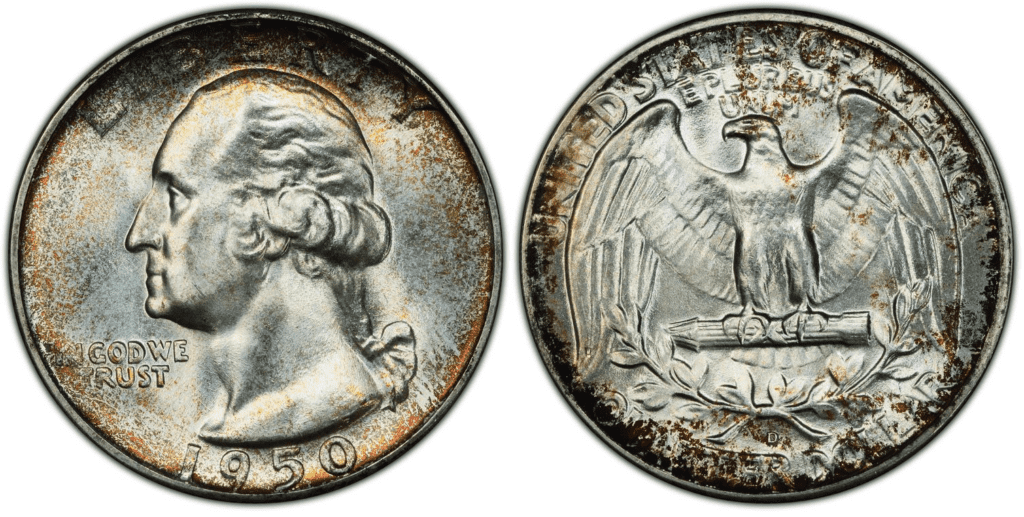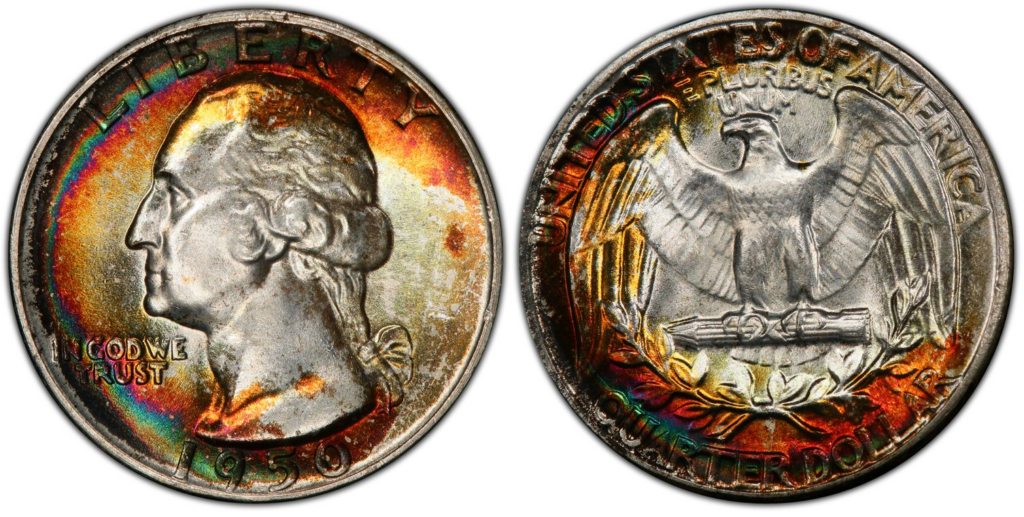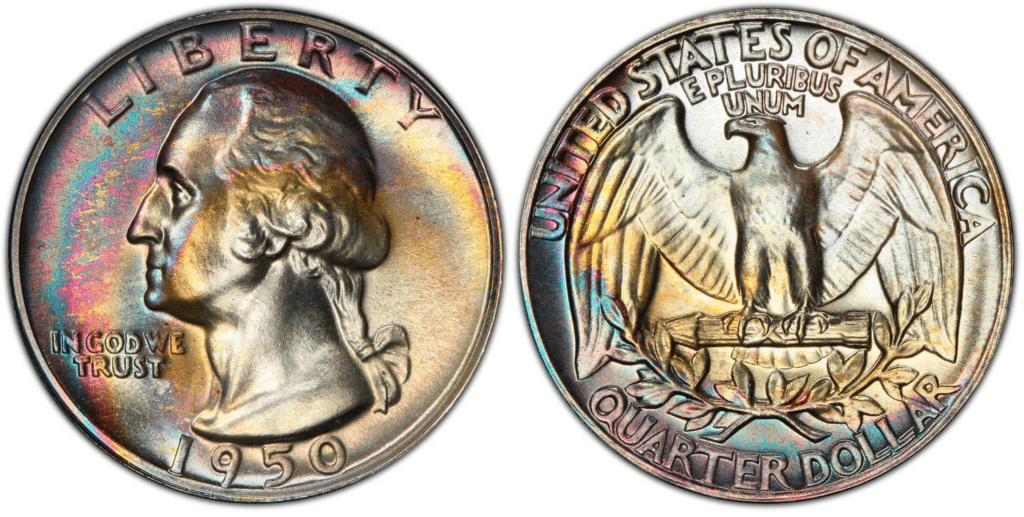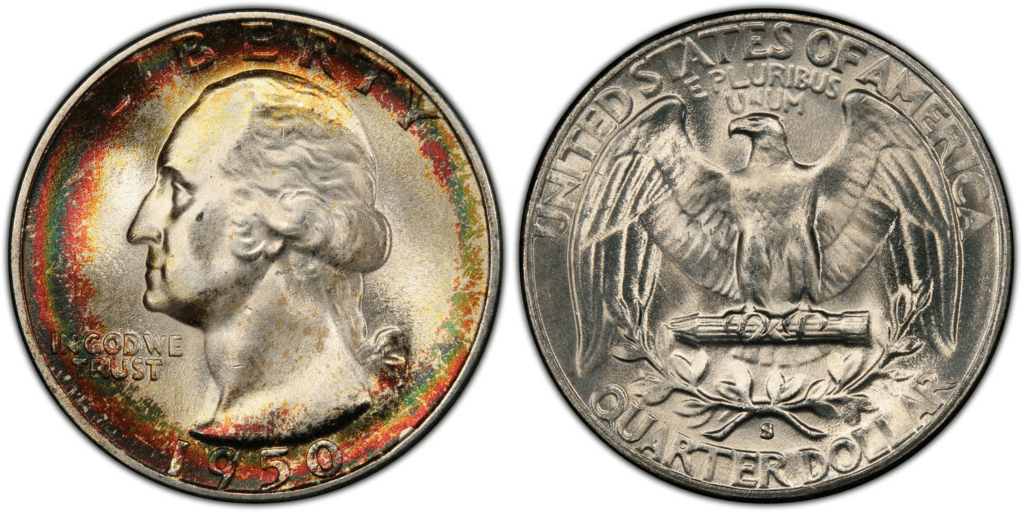What Is the 1950 Washington Quarter Made Of?
The 1950 Washington quarter is made of 90% silver and 10% copper. The coin has an actual silver weight (ASW) of 0.1808oz. It has a face value of 25 cents, a diameter of 24.30 millimeters, a weight of 6.30 grams, and a reeded edge.
The Washington quarter was first issued in 1932, and the US Mint produced it until today. Thus, it is among the most long-lasting coinage in the United States.

John Flanagan designed the Washington quarter, which would remain the design of choice until 1998. His design includes George Washington, the first president of the United States, on the obverse side of the coin. Inscriptions include the following:
- LIBERTY
- IN GOD WE TRUST
- 1950
On the reverse side of the coin, the heraldic eagle has its wings outspread. It holds a bundle of arrows in its talons. Underneath the eagle is olive branches. Inscriptions include the following:
- UNITED STATES OF AMERICA
- E PLURIBUS UNUM
- QUARTER DOLLAR
While the 1950 quarter was made of silver, it transitioned to base metals in 1965. The reason is that in 1964, there was a shortage of coins due to the rising price of silver. This has been made worse by the public’s hoarding of the popular silver Washington coin.
Eventually, President Lyndon Johnson announced in 1965 that silver would be removed from the dime and quarter.
The history of the Washington quarter is long and interesting. No matter what happens, the Washington quarter has already made its mark in the history of the United States.
1950 Washington Quarter Varieties
In 1950, the US Mint produced more than 56 million Washington quarters through its Philadelphia, San Francisco, and Denver Mint Centers. The Philadelphia Mint produced the most number of Washington quarters for almost 25 million. The Philadelphia Mint also produced both standard-struck and proof-struck coins.
For the 1950 Washington quarter, there were four varieties produced. These are the 1950 D, 1950 P with no mint mark, 1950-S, and the 1950 P proof Washington Quarter.
Aside from the standard-issued varieties, there are also those error coins that sporadically appear. The most notable errors were the D over S and S over D overmark errors.
Here’s a quick breakdown of the mintage figures for the 1950 Washington quarter:
| Mint Center | Type | Mintage |
| Denver | Regular strike | 21,075,600 |
| Philadelphia | Regular strike | 24,920,126 |
| Philadelphia | Proof strike | 51,386 |
| San Francisco | Regular strike | 10,284,004 |
| Total | 56,331,116 |
Take a look at the 1950 Washington quarter varieties below:
1950 D Washington Quarter
Edge: Reeded
Mint Mark: D
Place of minting: Denver
Year of minting: 1950
Face Value: $0.25 (twenty-five cent)
Price: $0.25 to $23 (or more)
Quantity produced: 21,075,600
Designer: John Flanagan
Composition: 90% silver and 10% copper
Mass: 6.30 grams
Diameter: 24.3 millimeters
Thickness: 1.75 millimeters

photo source: PCGS
The 1950 D Washington quarter was struck in the Denver Mint. All 1950 quarters struck in Denver bear the D mint mark. The Denver Mint produced the second-highest number of 1950 D quarters with a mintage of 21,075,600. This figure is actually higher than 1949 but lower than the 1951 mintage figure.
The 1950-D has an average rarity. You should be able to find some of these coins in a Gem condition. If you ever want to buy one, the price may start at $0.25 to $25, depending on the coin’s condition.
1950 P Washington Quarter
Edge: Reeded
Mint Mark: No mint mark
Place of minting: Philadelphia
Year of minting: 1950
Face Value: $0.25 (twenty-five cent)
Price: $0.25 to $11 (or more)
Quantity produced: 24,920,126
Designer: John Flanagan
Composition: 90% silver and 10% copper
Mass: 6.30 grams
Diameter: 24.3 millimeters
Thickness: 1.75 millimeters

photo source: PCGS
The 1950-P quarter coin was made in the Philadelphia Mint. At the end of 1950, 24,920,126 P Washington quarter coins were produced, making it the highest mintage of a Mint center for that year. This means that the Philadelphia Mint produced the most number of Washington quarters in 1950.
In the following year, 1950, Philadelphia almost doubled its production of the Washington quarter.
1950-P quarters can easily be found in circulated conditions up to MS65 grade. Pricing may start at around $11.
1950 P Proof Washington Quarter
Edge: Reeded
Mint Mark: No mint mark
Place of minting: Philadelphia
Year of minting: 1950
Face Value: $0.25 (twenty-five cent)
Price: $10 to $32 (or more)
Quantity produced: 51,386
Designer: John Flanagan
Composition: 90% silver and 10% copper
Mass: 6.30 grams
Diameter: 24.3 millimeters
Thickness: 1.75 millimeters

photo source: PCGS
In 1950, there were only 51,386 proof quarter coins made by the Philadelphia mint, which is lower than what was produced in 1951 but higher than in 1949.
It should be remembered that the US Mint stopped producing proof coins after 1942 due to the war. The US Mint was poised to resume production in 1947 but couldn’t do it due to cost-cutting. Finally, in 1950, the proof coinage production was finally resumed. Thus, 1950 was actually the first year of minting proof coins after World War II.
Since it has been almost a decade since the Philadelphia Mint struck its last proof coins, it needed to relearn how to produce proof coins in 1950. This means that the early struck-proof coins weren’t fully brilliant. Any proof coins with Cameo and Deep Cameo surfaces are difficult to find today. The price starts from $10 to $32.
1950 S Washington Quarter
Edge: Reeded
Mint Mark: S
Place of minting: San Francisco
Year of minting: 1950
Face Value: $0.25 (twenty-five cent)
Price: $0.25 to $33 (or more)
Quantity produced: 10,284,004
Designer: John Flanagan
Composition: 90% silver and 10% copper
Mass: 6.30 grams
Diameter: 24.3 millimeters
Thickness: 1.75 millimeters

photo source: PCGS
The 1950 S Washington quarter was struck in the San Francisco Mint. All 1950 quarters struck in San Francisco bear the S mint mark. The San Francisco Mint produced 10,284,004, slightly higher than the Mint produced in 1951. The previous year, 1949, the San Francisco Mint didn’t produce any Washington quarters.
Price may range from $0.25 to $33. 1950-S is quite common up to MS67 grade. The most sought-after 1950-S quarters are the ones that look like proof coins. There were times when the San Francisco Mint repolished their die. Once they were done polishing, the first few batches of coins produced looked more beautiful than the others.
List of 1950 Washington Quarter Errors
There were over 56 million Washington quarters produced in 1950. So, it won’t come as a surprise to find some 1950 quarter error coins. As you can imagine, producing coins with this mintage could allow error coins to appear. That’s why you will find some 1950 Washington quarters with errors.
While different errors were made in the 1950 Washington quarter production, the most well-known are the D over S and S over D minting errors. The error happened when a different mint mark, in this case, D and S, were struck over each other.
So, how did this happen? In 1950, the Philadelphia mint received orders for new dies. The problem was that the Philadelphia Mint was also trying to save money. Since they have a spare die, an employee just changed the mintmark and overpunched the ordered die. Then later in the same year, the same thing happened, but with a different overpunched mint mark.
How Much Is The 1950 Washington Quarter Worth Today?
The 1950 Washington quarter has a face value of 25 cents. It has a higher melt value of $4.3349, which is something you expect since the coin is made of silver. The average value of the 1950 Washington quarter is $3.90. However, it can be higher if the quarter is still in good condition and possesses a rare attribute.
To give you an idea of how much this coin is worth, here’s a 1950 Washington Quarter values chart:
| Coin | Condition | Grade | Mintage | Value |
| 1950 D Washington Quarter | Circulated/mint | Not graded | 21,075,600 | $3.90 to $8 |
| 1950 D Washington Quarter | Uncirculated/mint | MS-66 | 21,075,600 | $39 to $325 |
| 1950 D Washington Quarter | Uncirculated/mint | MS-67 | 21,075,600 | $120 to $900 |
| 1950 D Washington Quarter | Uncirculated/mint | MS-68 | 21,075,600 | $3,738 to $7,638 |
| 1950 P Washington Quarter | Circulated/mint | Not graded | 24,920,126 | $3.90 to $8 |
| 1950 P Washington Quarter | Uncirculated/mint | MS-66 | 24,920,126 | $25 to $60 |
| 1950 P Washington Quarter | Uncirculated/mint | MS-67 | 24,920,126 | $120 to $930 |
| 1950 P Washington Quarter | Uncirculated/mint | MS-68 | 24,920,126 | $2,040 to $3,840 |
| 1950 P Proof Washington Quarter | Uncirculated/mint | Not graded | 51,386 | $8 to $32 |
| 1950 P Proof Washington Quarter | Uncirculated/mint | PR-67 | 51,386 | $95 to $300 |
| 1950 P Proof Washington Quarter | Uncirculated/mint | PR-68 | 51,386 | $384 to $900 |
| 1950 P Proof Washington Quarter | Uncirculated/mint | PR-69 | 51,386 | $863 to $1,783 |
| 1950 P Proof Washington Quarter | Cameo | PR-68 | 51,386 | $2,760 to $5,875 |
| 1950 P Proof Washington Quarter | Deep Cameo | PR-68 | 51,386 | $31,200 |
| 1950 S Washington Quarter | Circulated/mint | Not graded | 10,284,004 | $3.90 to $8 |
| 1950 S Washington Quarter | Uncirculated/mint | MS-66 | 10,284,004 | $34 to $46 |
| 1950 S Washington Quarter | Uncirculated/mint | MS-67 | 10,284,004 | $144 to $2,880 |
| 1950 S Washington Quarter | Uncirculated/mint | MS-68 | 10,284,004 | $1,175 to $3,600 |
As you can see, the 1950 Washington quarter can be so valuable that some were sold for hundreds and thousands of dollars. Can you imagine how a coin with a face value of 25 cents can be sold for this much?
Now, to really see the value of the 1950 quarter, check out these auction records for each variety:
- $31,200 – a 1950 25C, DCAM (Proof) with a grade of PR68 DCAM sold in January 2022 by Heritage Auctions
- $19,800 – a 1950-S 25C (Regular Strike) with a grade of MS68 sold in March 2021 by Stack’s Bowers
- $7,638 – a 1950-D 25C (Regular Strike) coin with a grade of MS68 CAC sold in November 2013 by Heritage Auctions
- $5,288 – a 1950 25C (Regular Strike)with a grade of MS67 sold in January 2013 by Heritage Auctions
How Does The Grading System Work?
The Sheldon Scale is used by numismatists to provide a numerical value to coins. The Sheldon Scale goes from poor (P-1) to perfect mint state (P-1) (MS-70). Coins were originally evaluated using words to reflect their condition (Good, Fair, Excellent, Etc.). Unfortunately, coin collectors and dealers had different ideas about what each of these terms represent.
Professional numismatists joined together in the 1970s and established CoinGrading standards. These numismatists now assign grades at key places on the seventy-point scale, using the most regularly utilized numeric points in conjunction with the original adjective grade. The following are the most common coin grades:
-
-
- (P-1) Poor – Indistinguishable and probably damaged; if used, must have a date and mintmark; otherwise, rather battered.
- (FR-2) Fair – Nearly smooth, but without the damage that a coin graded Poor often possesses. The coin must have enough detail to be identified.
- (G-4) Fair – Inscriptions have merged into the rims in some areas, and important elements have been mostly erased.
- (VG-8) Very Good- A little weathered, but all of the primary design elements are visible, albeit faintly. There is little if any, central detail left.
- (F-12) Good – The item is very worn, yet the wear is even, and the overall design details stand out clearly. Rims are almost completely isolated from the field.
- (VF-20) Very Fine – Moderately weathered, with some finer features still visible. The motto or all letters of LIBERTY are readable. Both sides of the coin have entire rims that are separated from the field.
- (EF-40) Extremely Fine – Gently used; all gadgets are visible, and the most important ones are bold. The finer details are bold and clear, however, light wear may be seen.
- (AU-50) Uncirculated – Slight evidence of wear on the coin’s design’s high points; may have contact marks; eye appeal should be adequate.
- (AU-58) Uncirculated Choice – Slight traces of wear, no severe contact marks, almost full mint shine, and great eye appeal.
- (MS-60) Mint State Basal – Strictly uncirculated; no indication of wear on the coin’s highest points, but an unsightly coin with reduced luster, visible contact marks, hairlines, and other flaws.
- (MS-63) Mint State Acceptable – Uncirculated, but with contact scratches and nicks, little reduced shine, but otherwise appealing appearance. The strike is weak to average.
- (MS-65) Mint State Choice – Uncirculated with great mint shine, very little contact blemishes, and exceptional eye appeal. The strike is unusually severe.
- (MS-68) Mint State Premium Quality – Uncirculated with superb luster, no obvious contact marks to the naked eye, and exceptional eye appeal. The strike is quick and appealing.
- (MS-69) Almost Perfect Mint State – Uncirculated with perfect brilliance, a sharp and appealing strike, and extremely good eye appeal. A near-perfect coin with minor imperfections in the planchet, strike, and contact markings (seen only under 8x magnification).
- (MS-70) Mint State Perfect – Under 8x magnification, there are no tiny imperfections discernible; the strike is crisp, and the coin is perfectly centered on a beautiful planchet. Rarely seen on a coin, this coin is bright and whole, with original luster and exceptional eye appeal.
-
Where To Buy Or Sell 1950 Washington Quarter?
The 1950 Washington quarter should be available in the market today. You can search for it on the Internet, especially on eBay and Amazon. Other websites specialize in buying and selling Washington quarters, such as USA Coin Book, JM Bullion, and CoinTrackers.
You can also go to coin shops, antique stores, pawnshops, and auction houses to buy or sell the 1950 Washington quarters.
FAQs
Does a 1950 quarter have silver?
The 1950 quarter has silver. To be precise, it is composed of 90% silver with an actual silver weight of 0.1808oz.
How much is the 1950 all-silver quarter worth?
There is no 1950 quarter that is made of 100% silver. Instead, you will find 1950 quarters made of 90% silver and 10% copper. The price of a 1950 silver quarter starts at around $3 to $4.
What could a quarter buy in 1950?
With a quarter, you can buy a loaf of bread, a gallon of gas, a milkshake, and even a ballpoint pen in 1950.




